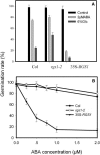The regulator of G-protein signaling proteins involved in sugar and abscisic acid signaling in Arabidopsis seed germination
- PMID: 16361523
- PMCID: PMC1326052
- DOI: 10.1104/pp.105.069872
The regulator of G-protein signaling proteins involved in sugar and abscisic acid signaling in Arabidopsis seed germination
Abstract
The regulator of G-protein signaling (RGS) proteins, recently identified in Arabidopsis (Arabidopsis thaliana; named as AtRGS1), has a predicted seven-transmembrane structure as well as an RGS box with GTPase-accelerating activity and thus desensitizes the G-protein-mediated signaling. The roles of AtRGS1 proteins in Arabidopsis seed germination and their possible interactions with sugars and abscisic acid (ABA) were investigated in this study. Using seeds that carry a null mutation in the genes encoding RGS protein (AtRGS1) and the alpha-subunit (AtGPA1) of the G protein in Arabidopsis (named rgs1-2 and gpa1-3, respectively), our genetic evidence proved the involvement of the AtRGS1 protein in the modulation of seed germination. In contrast to wild-type Columbia-0 and gpa1-3, stratification was found not to be required and the after-ripening process had no effect on the rgs1-2 seed germination. In addition, rgs1-2 seed germination was insensitive to glucose (Glc) and sucrose. The insensitivities of rgs1-2 to Glc and sucrose were not due to a possible osmotic stress because the germination of rgs1-2 mutant seeds showed the same response as those of gpa1-3 mutants and wild type when treated with the same concentrations of mannitol and sorbitol. The gpa1-3 seed germination was hypersensitive while rgs1-2 was less sensitive to exogenous ABA. The different responses to ABA largely diminished and the inhibitory effects on seed germination by exogenous ABA and Glc were markedly alleviated when endogenous ABA biosynthesis was inhibited. Hypersensitive responses of seed germination to both Glc and ABA were also observed in the overexpressor of AtRGS1. Analysis of the active endogenous ABA levels and the expression of NCED3 and ABA2 genes showed that Glc significantly stimulated the ABA biosynthesis and increased the expression of NCED3 and ABA2 genes in germinating Columbia seeds, but not in rgs1-2 mutant seeds. These data suggest that AtRGS1 proteins are involved in the regulation of seed germination. The hyposensitivity of rgs1-2 mutant seed germination to Glc might be the result of the impairment of ABA biosynthesis during seed germination.
Figures






Similar articles
-
Identification, cloning and characterization of sis7 and sis10 sugar-insensitive mutants of Arabidopsis.BMC Plant Biol. 2008 Oct 14;8:104. doi: 10.1186/1471-2229-8-104. BMC Plant Biol. 2008. PMID: 18854047 Free PMC article.
-
G-protein complex mutants are hypersensitive to abscisic acid regulation of germination and postgermination development.Plant Physiol. 2006 May;141(1):243-56. doi: 10.1104/pp.106.079038. Epub 2006 Mar 31. Plant Physiol. 2006. Retraction in: Plant Physiol. 2019 Nov;181(3):1393. doi: 10.1104/pp.19.01182. PMID: 16581874 Free PMC article. Retracted.
-
AtRGS1 function in Arabidopsis thaliana.Methods Enzymol. 2004;389:338-50. doi: 10.1016/S0076-6879(04)89020-7. Methods Enzymol. 2004. PMID: 15313575 Review.
-
Role of a heterotrimeric G protein in regulation of Arabidopsis seed germination.Plant Physiol. 2002 Jun;129(2):897-907. doi: 10.1104/pp.005017. Plant Physiol. 2002. PMID: 12068128 Free PMC article.
-
Progress of ABA function in endosperm cellularization and storage product accumulation.Plant Cell Rep. 2024 Nov 20;43(12):287. doi: 10.1007/s00299-024-03378-6. Plant Cell Rep. 2024. PMID: 39565413 Review.
Cited by
-
Heterotrimeric G-protein α subunit (LeGPA1) confers cold stress tolerance to processing tomato plants (Lycopersicon esculentum Mill).BMC Plant Biol. 2020 Aug 26;20(1):394. doi: 10.1186/s12870-020-02615-w. BMC Plant Biol. 2020. PMID: 32847511 Free PMC article.
-
GTPase acceleration as the rate-limiting step in Arabidopsis G protein-coupled sugar signaling.Proc Natl Acad Sci U S A. 2007 Oct 30;104(44):17317-22. doi: 10.1073/pnas.0704751104. Epub 2007 Oct 19. Proc Natl Acad Sci U S A. 2007. PMID: 17951432 Free PMC article.
-
Protein-protein interactions in plant antioxidant defense.Front Plant Sci. 2022 Dec 14;13:1035573. doi: 10.3389/fpls.2022.1035573. eCollection 2022. Front Plant Sci. 2022. PMID: 36589041 Free PMC article. Review.
-
AtGAP1 Promotes the Resistance to Pseudomonas syringae pv. tomato DC3000 by Regulating Cell-Wall Thickness and Stomatal Aperture in Arabidopsis.Int J Mol Sci. 2022 Jul 7;23(14):7540. doi: 10.3390/ijms23147540. Int J Mol Sci. 2022. PMID: 35886893 Free PMC article.
-
Convergence and Divergence of Sugar and Cytokinin Signaling in Plant Development.Int J Mol Sci. 2021 Jan 28;22(3):1282. doi: 10.3390/ijms22031282. Int J Mol Sci. 2021. PMID: 33525430 Free PMC article. Review.
References
-
- Bechtold N, Pelletier G (1998) In planta Agrobacterium-mediated transformation of adult Arabidopsis thaliana plants by vacuum infiltration. Methods Mol Biol 82: 259–266 - PubMed
-
- Berman DM, Kozasa T, Gilman AG (1996) The GTPase-activating protein RGS4 stabilizes the transition state for nucleotide hydrolysis. J Biol Chem 271: 27209–27212 - PubMed
-
- Chen JG, Jones AM (2004) AtRGS1 function in Arabidopsis thaliana. Methods Enzymol 389: 338–350 - PubMed
Publication types
MeSH terms
Substances
LinkOut - more resources
Full Text Sources
Molecular Biology Databases

